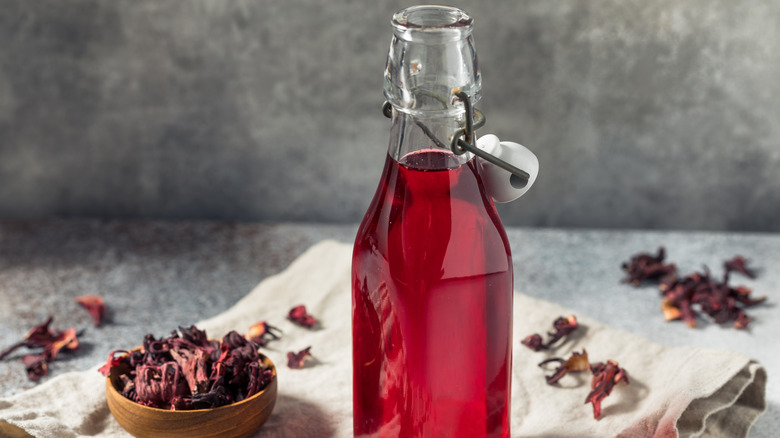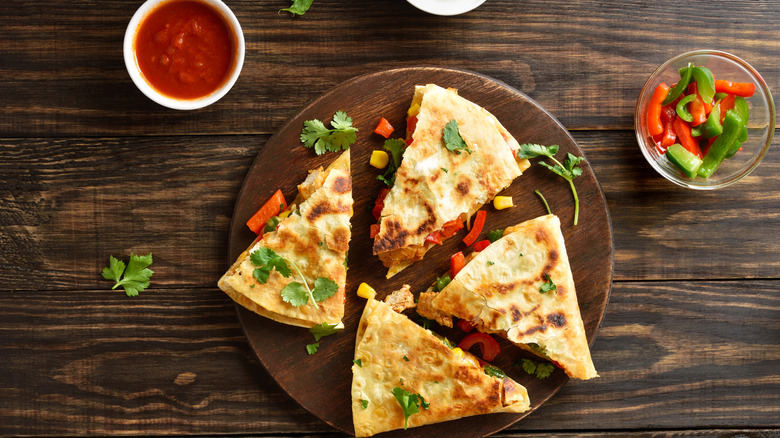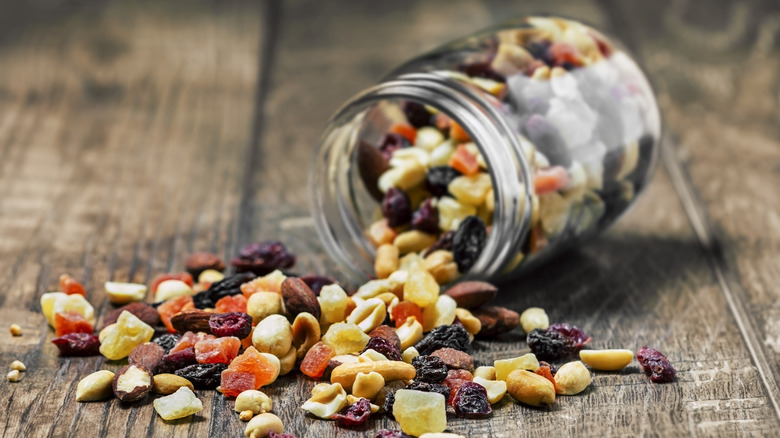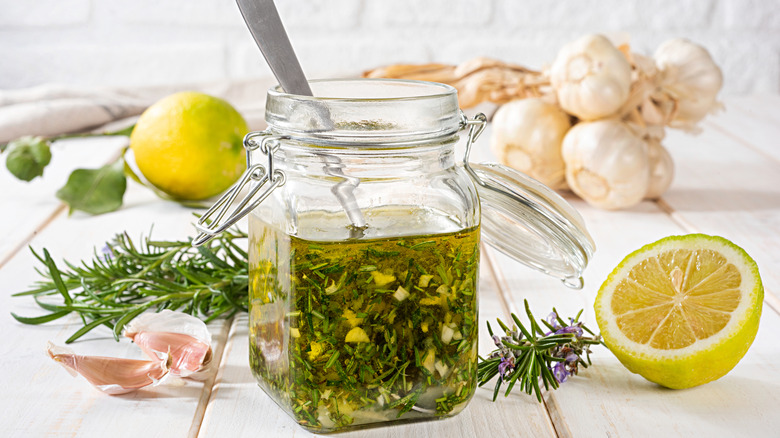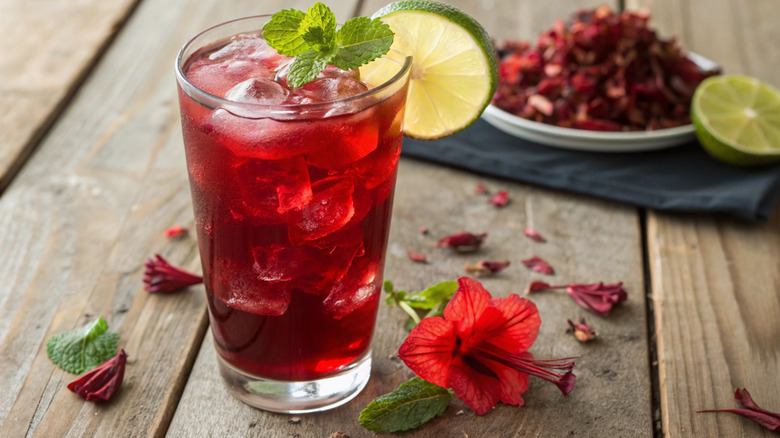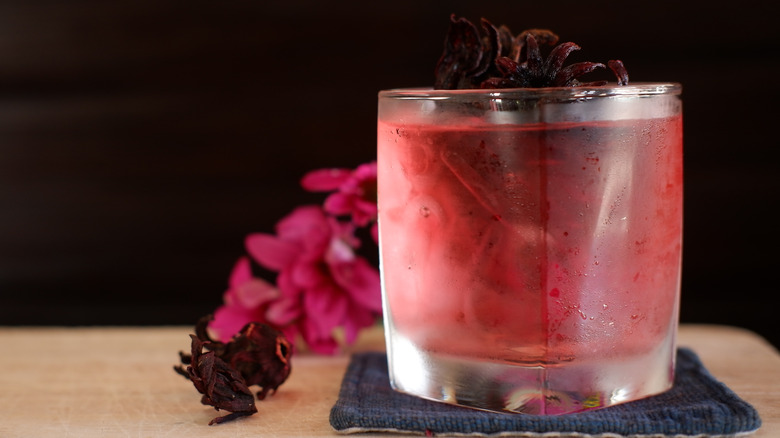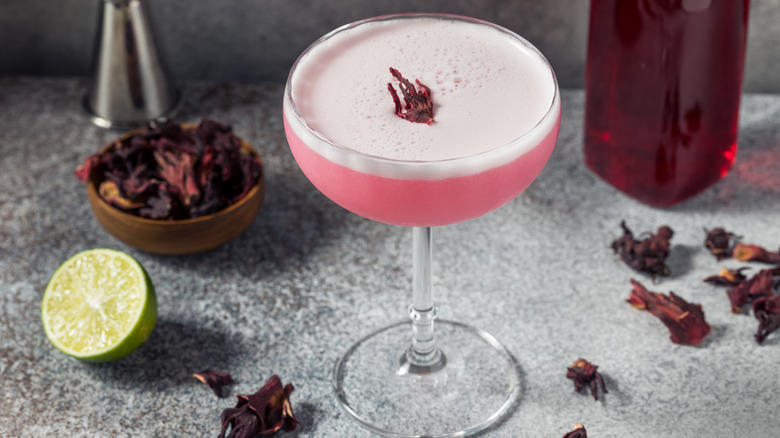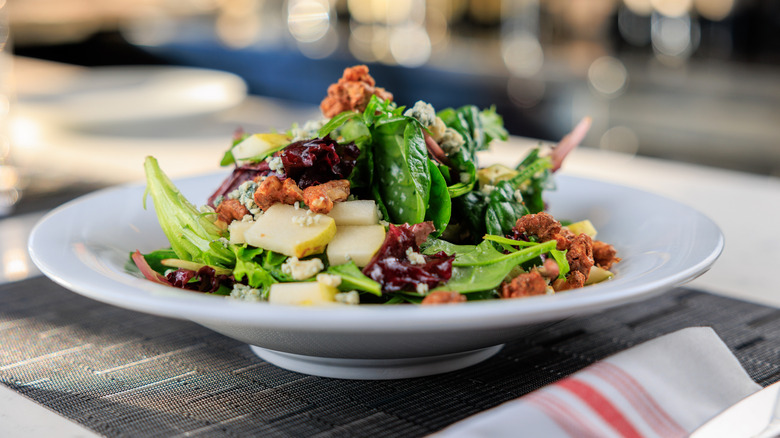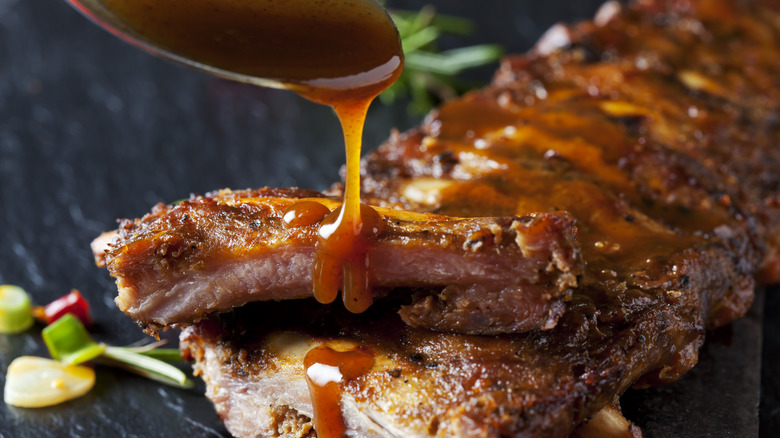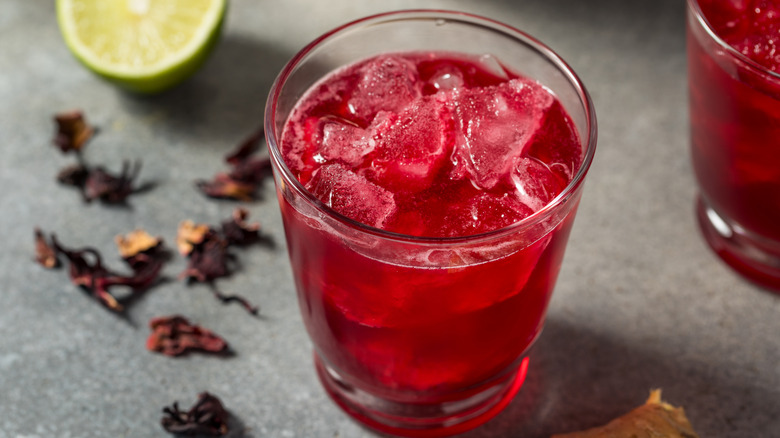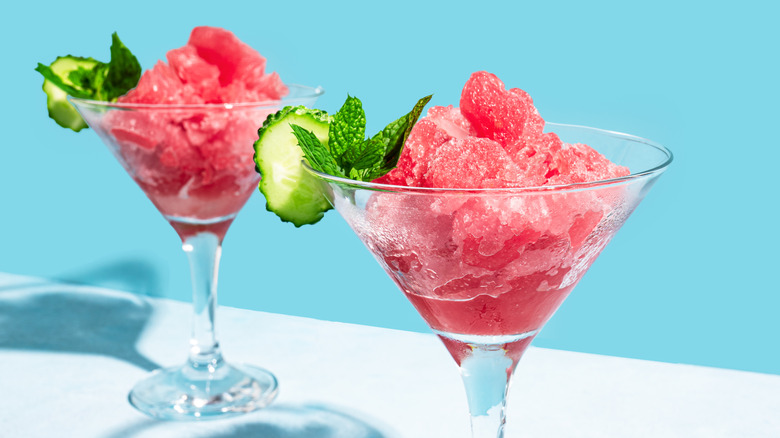How To Use Hibiscus To Elevate Your Summer Dishes And Drinks
Cooking and garnishing with edible hibiscus flowers is an easy way to give any dish or drink an exotic flair, as well as infuse it with vibrant color and flavor. There are several different varieties of hibiscus flowers, such as the Hawaiian hibiscus, which is grown in tropical climates, but not all are safe to consume. The specific type that is edible and used in cooking is called hibiscus sabdariffa, or hibiscus roselle. Using hibiscus to enhance food and drinks is especially popular in the Caribbean, Africa, and throughout South Asia.
Hibiscus lends a tart-floral note to a wide range of summer dishes and refreshing beverages, and turns everything from cocktails to sauces a deep, eye-catching crimson hue. Edible hibiscus is known for its cranberry-like tang, which pairs well with tropical fruits, bright citrus flavors, and works in both sweet and savory recipes. The tasty bloom can be consumed either as a fresh or dried flower, or as a powder. Its shoots and leaves are also edible. Not only is hibiscus delicious, it's also said to be packed with nutrients, including antioxidants. If you're looking for a way to instantly elevate your warm-weather food and drinks, such as salads and slushes, look no further than hibiscus flowers.
Infuse it in a simple syrup for iced drinks
Simple syrup is a versatile sweetener used in a wide range of dishes and drinks, from desserts to cocktails. The syrup is easy to make at home by combining equal parts water and sugar, and simmering it in a pan until the crystals are completely dissolved. To infuse your homemade simple syrup with the unique sweet and tart flavor of hibiscus, add a few of the dried flowers into the simmering sugar water. The water will turn an aesthetically appealing rose hue, which will further enhance your food and beverages.
You can use the hibiscus simple syrup to add subtle sweetness, and a soft floral note to sparkling water, iced tea, lemonade, and a variety of different summery cocktails. Hibiscus simple syrup is also delicious drizzled over pancakes and waffles, yogurt, and even a bowl of ice cream. The sweetener's ruby color will liven up boring beverages and bland dishes in addition to adding a sweet touch. Get creative by blending the dried flowers with other herbs and spices, including ginger and cloves, to customize any recipe.
Incorporate it into tacos and quesadillas
You may be surprised to learn that you can make mouthwatering vegan and vegetarian tacos and quesadillas using dried hibiscus flowers. Most commonly associated with sweet dishes and drinks, these pretty petals can also be transformed into a meaty, flavor-packed filling. On menus, these tasty treats are sometimes referred to as "jamaica tacos" or "tacos de jamaica." When the flowers are boiled until they're soft and then sauteed with garlic, onion, and other seasonings and aromatics, they make a taco and quesadilla filling that rivals chicken, steak, and other common carnivore fillings. Although the red petals will still retain a bit of their signature tartness when boiled, they are a lot less sour after the hot bath.
To create a taco or quesadilla that's colorful, bold, and layered with flavor, get creative by mixing the boiled and sauteed hibiscus petals with chipotle sauce for smoky depth, or pineapple as a sweet contrast. Use the floral filling in the same way as its more traditional meat counterpart, and then add toppings, such as sour cream, cheese, and cilantro to make the Mexican dishes your own. You can also use mustard as an unexpected way to elevate taco night.
Sprinkle it into colorful baked goods
Another way to enhance your summer fare with hibiscus flowers is by incorporating them into baked goods. Bake up a batch of petal-studded cupcakes or cookies for a birthday party, a Fourth of July get-together, or just as a way to celebrate the season. Hibiscus will give your baked goods a bright, tangy flavor similar to dried cherries and cranberries, as well as vibrant color. The flower also has a slight chewy texture. Baking with hibiscus is ideal for those who want to infuse their treats with petals without the strong floral taste typically associated with rose or lavender.
Using dried hibiscus flowers in your baking will elevate even the simplest of recipes, such as basic yet delicious shortbread cookies or vanilla cake. Depending on what type of baked goods you're making and what you have on hand, there are several ways that you can add hibiscus to your recipes. For instance, sprinkling some hibiscus powder into a cake mix will give it a jewel tone and a slightly tart flavor. As another option, sprinkle chopped, candied hibiscus flowers into cupcake or cookie batter. Swirl hibiscus syrup into cheesecake for a marbled effect, or use it to add vibrant color to homemade icing or frosting, which you can take to the next level with one specific ingredient.
Add a bit to granola or trail mix for summer snacks
Another simple way to enjoy hibiscus in the summer months is by adding the dried flowers to your granola or trail mix. You can use the tart petals to add a tangy bite and vibrant color to either homemade or store-bought mixes. Since candied hibiscus petals have a similar flavor and consistency to several types of dried fruit, you can use the dried flowers in place of the fruit. The floral elements will also work well with tropical dried fruits, such as pineapple and mango. It's suggested that a good trail mix contains a ratio of 50% nuts, 30% dried fruit (or in this case, hibiscus flowers), 10% seeds, and 10% treats, including chocolate chips and sweetened coconut flakes. If you're making your candied hibiscus-infused trail mix from scratch, consider complementing the hibiscus with various roasted nuts such as cashews and almonds, pumpkin or sunflower seeds, and your favorite bite-sized sweets.
If you prefer to make hibiscus-infused granola instead, start by combining dried, coarsely chopped petals with old-fashioned rolled oats. Next, add in other ingredients you'd like, including almonds, cashews, hazelnuts, seeds, and dried fruit. Toss everything with maple syrup and a bit of oil, and bake in your oven until the mixture is crisp. As an alternative method, put the granola in an air fryer for a toasty crunch. You can then snack on the granola alone, or in milk as a fast and easy summer breakfast.
Use it to flavor vinaigrettes
Are you looking for a way to give a fresh garden salad a creative touch? Try tossing it with a flavorful hibiscus-infused vinaigrette to impress the guests of your next summer BBQ. Making the homemade dressing is a tasty way to bring floral brightness and a sweet and tart flavor to your salads. Crafting your vinaigrette takes just a few minutes and is an instant upgrade to store-bought versions. You can also make extra dressing and store it in glass bottles for future vegetable and pasta salads.
To make the floral vinaigrette, begin by steeping dried hibiscus petals in hot water to create rich crimson-colored liquid that's tart and concentrated with flavor. Cool and strain the hibiscus infusion, and whisk it with either balsamic or red wine vinegar, olive oil, honey, and Dijon mustard until it becomes emulsified. It's now ready to toss with greens, and fresh or roasted vegetables, such as beets. If you prefer a creamier version, blend a bit of Greek yogurt or crème fraîche into the vinaigrette.
Make iced hibiscus tea
There's nothing more refreshing than a glass of iced tea on a hot summer day, and infusing it with dried hibiscus petals gives it an unexpected cranberry-like flavor. Not only will this ruby-colored beverage quench your thirst, it also offers health benefits since it's loaded with antioxidants such as vitamin C and beta-carotene. While it's best served chilled in the summertime, you can also heat the tea in the winter for a cozy, warming drink.
Making iced hibiscus tea requires just a few ingredients that you most likely already have on hand. Begin by steeping ½ cup of dried petals for every 4 cups of boiling water for at least 15 minutes, or until the liquid is a deep ruby color. Strain the tea, and sweeten it with sugar, honey, or agave syrup while it's still warm if you desire. Chill the liquid, and then pour the tea into glasses of ice. You can enjoy the chilled tea as is, or add a splash of apple or pineapple juice for a more customized flavor.
Garnish a summery dessert or drink with it
Not only is hibiscus delicious to eat, it also makes a beautiful garnish for both desserts and alcoholic and non-alcoholic drinks. The vivid crimson petals will add a summery visual flourish to food and beverages, whether used in fresh or dried form. Hibiscus garnishes work especially well in desserts and drinks that are already infused with the flowers, whether it's a cake or a cocktail. You can also use the hibiscus petals in unison with other types of edible flowers, such as roses, nasturtium, pansies, and honeysuckles, for a beautiful summer-inspired look.
If you're using hibiscus to garnish desserts, you'll have no shortage of creative options. As one idea, use several fresh hibiscus blooms to decorate the top of a frosted cake, or place one flower on top of each cupcake. Sprinkle a selection of edible flowers, such as hibiscus, across the top of a curd, tart or pie for a bouquet of vibrant colors. For drinks, place a few fresh or dried petals on top of a pink, hibiscus syrup-infused cocktail, or a glass of iced tea or lemonade. It's always important to garnish your cocktails for several reasons, and not just for aesthetic value. You can also freeze the flowers in ice cubes for a stunning suspended appearance. Floral ice is a fun way to brighten up your favorite cocktails.
Whip up a flowery alcoholic beverage
Another intoxicating way to use hibiscus in your summer dishes and drinks is in alcoholic beverages. The pretty petals have the power to transform classic cocktails into vibrant sensory experiences, with both their tart, cranberry-like flavors and stunning ruby color. The tanginess of hibiscus blends beautifully with a wide range of spirits, including rum, gin, tequila, and vodka, as well as many mixers. The dried flowers will give any clear alcohol either a pink blush or a deep red hue, depending on how much you use and the length of time you infuse the petals in the booze. Hibiscus-infused simple syrup is another crafty way to incorporate the flower into drinks.
To make a batch of fruity sangria, you can start with a base of hibiscus herbal tea, and mix in white wine such as sauvignon blanc, prosecco, or moscato for a touch of sweetness. Add in any type of fruit you'd like, including sliced lemons and oranges, grapes, berries, stone fruits, or even apples. For a summer sangria, stir in some frozen fruit to make the drink even more refreshing. Hibiscus tea will also add botanical complexity to a French 75 or a gin spritz. Use either fresh or dried hibiscus petals to garnish the drink glasses for a bit of floral flair.
Enhance a summer salad with shoots and leaves
Hibiscus petals aren't the only edible part of the flower – you can also eat its shoots and leaves. Use them to add an unexpected touch and a fresh lemony zing to summer garden salads or a platter of roasted or grilled vegetables. Hibiscus shoots and young leaves lend a tangy brightness to salads, as well as vibrant color for aesthetic value. The plant's leaves are a deep red color similar to its flowers, so they'll stand out in a bowl of mixed greens. Hibiscus leaves have a subtle, earthy flavor similar to sorrel, which blends well with an assortment of fresh vegetables such as tomatoes, cucumbers, bell peppers, and sugar snap peas. They're also delicious with slightly tart fruits, including pomegranates and Granny Smith apples.
Hibiscus shoots are tender with a slight crunch, and also make delicious additions to a variety of salads. You can also roast them along with a selection of fresh vegetables to serve with grilled meat at a summer BBQ. Due to the tart and fruity flavor of the hibiscus leaves, you can use them in place of cranberries in a salad. They also blend well with a citrusy, hibiscus-infused vinaigrette.
Use it in a BBQ marinade
Another surprisingly delicious way to enhance your summer dishes with hibiscus is by infusing your BBQ marinades with it. The flower's bright and sweet flavor tinged with a bit of earthiness, works well with a variety of grilled meats, from the heartiest of steaks to legs of lamb. You can also use the botanical marinade to enhance tofu and seafood, if meat isn't on your menu. A good BBQ marinade combines smoky, savory, sweet, and tangy flavor notes, and hibiscus will bring a tart bite to the backyard party. The petals will also blend deliciously with spicy ingredients, such as jalapeño, chili, and chipotle, if you want to heat up your meaty marinade.
One way of incorporating hibiscus into our marinade is by steeping the dried flowers in boiling water, which will become the liquid base to the sauce. Mix in other marinade ingredients, including tomato paste, apple cider vinegar, spices, and honey for sweetness. You can also add some liquid smoke to the marinade for an extra-smoky flavor. Place the meat or seafood in the marinade and refrigerate overnight so that it soaks up all of the floral goodness. You can also brush the marinade on the meat during the grilling process for a more intense flavor.
Transform it into refreshing paletas
Perhaps the most refreshing way to incorporate hibiscus into your summer cuisine is by making tasty, Mexican-inspired paletas. Start the process by creating a concentrated hibiscus tea by boiling the dried petals in water. After the hibiscus is steeped and the liquid is a rich ruby red color, you can then add in other ingredients to craft customized paletas to reflect your specific tastes and preferences. Your flavor combination options are endless, ranging from simple hibiscus and lime to a more gourmet hibiscus, blood orange, and cardamom blend. As a tropical twist, blend the hibiscus infusion with pineapple juice and coconut water.
To sweeten the paletas, add white or brown sugar, agave syrup, or honey to the liquid. If you prefer a creamier paleta, mix in a bit of coconut cream. Pour the hibiscus-infused mixture into popsicle molds, insert wooden sticks, and freeze overnight to enjoy on a hot summer day.
Make agua de jamaica
When you have a thirst for something a little more exotic than iced tea, make a batch of agua de jamaica using dried hibiscus flowers. Popular at Mexican taquerias, the sweet and tart beverage is simple to make using just a handful of ingredients. Due to the addition of the hibiscus petals, the drink has a flavor similar to cranberry juice, and is refreshingly tangy like lemonade. In addition to the hibiscus, traditional agua de jamaica blends ingredients such as cinnamon sticks, ground cloves, allspice, and nutmeg, and slices of ginger to give the drink its signature spicy flavor. You can also add fresh lime juice for extra tartness, as well as sugar or agave syrup if you prefer a sweeter beverage.
To make the flavorful infusion, boil water with the sugar and spices, and then steep the dried hibiscus in it. Strain the vibrant red liquid to remove any solid pieces, and then pour it into a pitcher before chilling in your refrigerator. Serve the aqua de jamaica over ice, and garnish the glass with a lime wedge for an extra pop of color.
Create sweet and tart granitas
Sweet and tart granitas infused with the cranberry-like flavor of hibiscus are a delicious way to cool off on sweltering summer days. Icy granitas are typically served as light desserts and are ideal for summertime parties and gatherings when you crave something less rich than ice cream. Granitas are known for their smooth, almost creamy, texture and deep, concentrated flavor, and couldn't be easier to make. The secret to creating the perfect, palate-pleasing texture is to mash the mixture down several times during the freezing process to break down any large pieces. The result is a fluffy frozen treat similar to shaved ice.
To make hibiscus-flavored granitas, start by making an infusion with dried flowers and boiling water. You can also brew hibiscus tea bags for convenience. Strain the hibiscus petals with a fine mesh sieve, and then add any other ingredients you'd like, such as sugar, agave syrup, or fruit juice or puree. Pour the mixture into a metal pan and freeze, scraping the top layer down with a fork several times over four hours, or until the texture of the granitas is light and fluffy.

